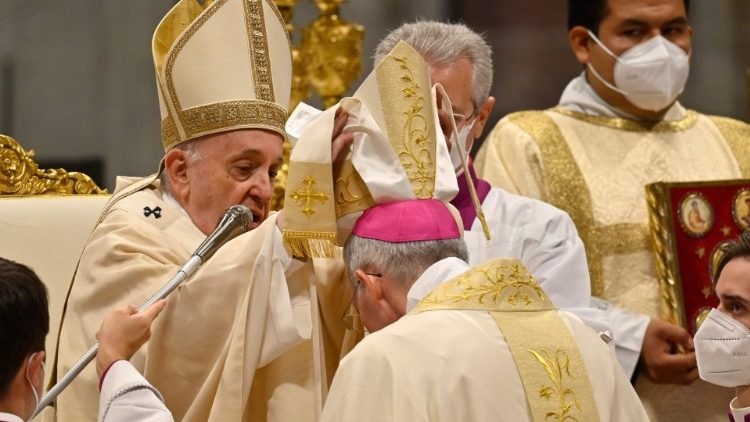Bishop Marini recalls Pope Francis’ love for Our Lady
Bishop Guido Marini, who served for 8 years as Pope Francis’ Master of Liturgical Celebrations, celebrates a memorial Mass and recounts his memories of the faith and humanity of the late Pope.
Apr 30, 2025

VATICAN: "With the Blessed Virgin Mary, you don’t split hairs."
Bishop Guido Marini, Bishop of the Italian diocese of Tortona and former Master of Pontifical Liturgical Celebrations, said those were Pope Francis’ words to him in the early days of his pontificate.
In his homily at a memorial Mass celebrated in his Cathedral on April 23, the Bishop recalled the late Pope’s devotion to Our Lady.
“His desire, expressed even in his Testament, was to be buried in the Basilica of St. Mary Major, near the Chapel of Salus Populi Romani, where he went many times during his pontificate, before and after every trip and on many other occasions,” said Bishop Marini. “But I want to recall two episodes in particular. We were at the beginning of the pontificate... and the statue of Our Lady of Fatima had been brought to St. Peter’s Square. The Pope was scheduled to perform an act of veneration, and it was thought he should place a rosary in the hands of the Madonna.”
Golden rosary for the Virgin of Fatima
“So, I began searching for a rosary,” continued Bishop Marini, “but I found nothing meaningful except for a very, very beautiful, golden rosary. And I must say I was a bit embarrassed, especially because I already knew well that the Pope loved simple, poor things. But there was little time, and I hadn’t found anything else that seemed significant. I went to the Pope and said, ‘Holy Father, I found a rosary…’ ‘Good, good, well done,’ he said. Then I added, ‘It’s a golden rosary.’ I was ready to hear him say ‘no, no, no,’ but instead he said: ‘It’s perfect, it’s perfect, because with the Madonna you don’t split hairs; a golden rosary is just fine.’”
Still speaking about Pope Francis’s Marian devotion, the Bishop of Tortona added: “During that celebration, they were carrying the Madonna on their shoulders from the obelisk up to the stage. Then they had to climb the stairs and reach the sanctuary. At one point, the Pope turned to me as the Madonna was approaching the steps and said: ‘Come, come, come, because you go to meet Our Lady—you don’t make her wait.’ That is the Pope’s deep, yet simple and popular devotion to the Madonna.”
Mercy
Bishop Marini then spoke about the central theme of the pontificate: mercy.
“I remember the first penitential liturgy in St. Peter’s Basilica that the Pope celebrated for Lent,” he recounted. “There was a moment when he and other priests positioned themselves in the confessionals to hear the confessions of those present, and I was tasked with accompanying him to his confessional. When we got close, he took a different path—unexpectedly—and went to another confessional nearby. He knelt before a confessor, who was stunned, and made his confession there so that everyone could see. Later in the sacristy, he told me: ‘Sorry I didn’t listen to you—I went another way—but I wanted this gesture from the Pope to help everyone understand the beauty of confession, the beauty of God’s mercy, to understand how drawing near to the Lord and asking for forgiveness is truly a reason for joy.’”
‘Living the Gospel is the true joy of life’
Referring to the joy of the Gospel—which gave the name to the Argentine Pope’s first apostolic exhortation—Bishop Marini recalled: “One time he said: ‘You see, I really enjoy going among the people with a smile on my lips, sometimes even making a little unexpected gesture, because I want to communicate the joy of the Lord. I want everyone to really feel that belonging to Him, living the Gospel, is the true joy of life. That’s it—the joy of the Gospel, the joy of Jesus.’”
The Bishop then recalled the word “Everyone,” repeated three times at the last World Youth Day in Lisbon: “Todos, todos, todos—everyone, everyone, everyone. What did he mean? That the Church must have in its heart the desire to reach everyone, to listen to everyone, to enter into dialogue with everyone, in order to bring to everyone the beauty of the Gospel that saves, and of the Lord who is the Savior.”
Theme of synodality
Bishop Marini also touched on synodality: “We were involved in this synodal journey, a journey the Pope wanted with determination. He wanted it—not to produce more documents. He told me this several times personally: ‘I’m not interested in more documents. What I care about is that this time, this journey helps all of us to live communion, participation, co-responsibility in a more meaningful, more authentic, deeper way—to truly be one body.’ Because, as the Pope well knew, mission only happens where there is communion, and it is only charity within the Church—communion within the Church—that enables it.”
Concern for the most vulnerable
Speaking of the Pope’s love for the poor, the former Master of Pontifical Liturgical Celebrations said: “He cared for the poor; he cared about all of humanity’s needs—and it wasn’t for show. One day, in the sacristy after a meeting with some poor people, I saw him crying—and he was really crying—because he felt humanity’s poverty in every form as his own sorrow, a personal sorrow, a pain that touched his heart. He really wept, with tears, in the secrecy of a sacristy, remembering a meeting he had with one of those poor. And I remember that just a few days after his election as Pope, when we went to a juvenile prison for Mass, he said to me: ‘You know, every time I come to one of these places, I ask myself—why them and not me? It could have been me.’ And he said: ‘Think about that.’”
Parish priest of the world
Bishop Marini also mentioned the Pope’s commitment to peace—as a prophet often unheard—who “never tired of proclaiming it, announcing it, asking for it as a gift for our poor world at war.”
He called him a shepherd who “passionately loved the world—and something that always struck me was that he was interested in everything, everything, because anything that concerned humanity concerned him. Every expression of humanity interested him. Everything that had to do with the human person was in his heart, and he made it his concern. He wanted to be... a bit like the parish priest of the world. Just think of the phone calls he made to ordinary people, or the handwritten notes he sent to every corner of the world. He held the world in his heart—and perhaps this aspect of his pontificate was crystallized forever in that March 27, 2020, during the year of Covid-19, when the Pope appeared alone in St. Peter’s Square. The eyes of the world were on that square, the eyes of the world were on the Pope, and at that moment, the Pope carried the whole world before the Lord. That, perhaps, will remain the most beautiful image of a Pope who truly always carried the world in his heart.”
Courage and freedom
Finally, the Bishop of Tortona remembered “the courage and the freedom” of the late Pope Francis.
“He wanted to contribute to the reform of the Church,” he said. “The Church, in every period of history, needs to be reformed in its human dimension. Why? Because over time, encrustations form, mechanisms that no longer work as they should. With courage and freedom, he tried to offer his contribution in this direction. And of course, this did not always make him well-liked. On the day of his inaugural celebration as Pope—you can imagine the jubilation in St. Peter’s Square. Returning to the sacristy, guess what he said: ‘You see, today’s jubilation of the people in St. Peter’s Square made me think of Jesus’ entry into Jerusalem. And then right after, I thought and said to myself—remember this when the days of the Passion and the Cross come.’ And so it was. Because that is how it is for all Popes.”--Vatican News







Total Comments:0